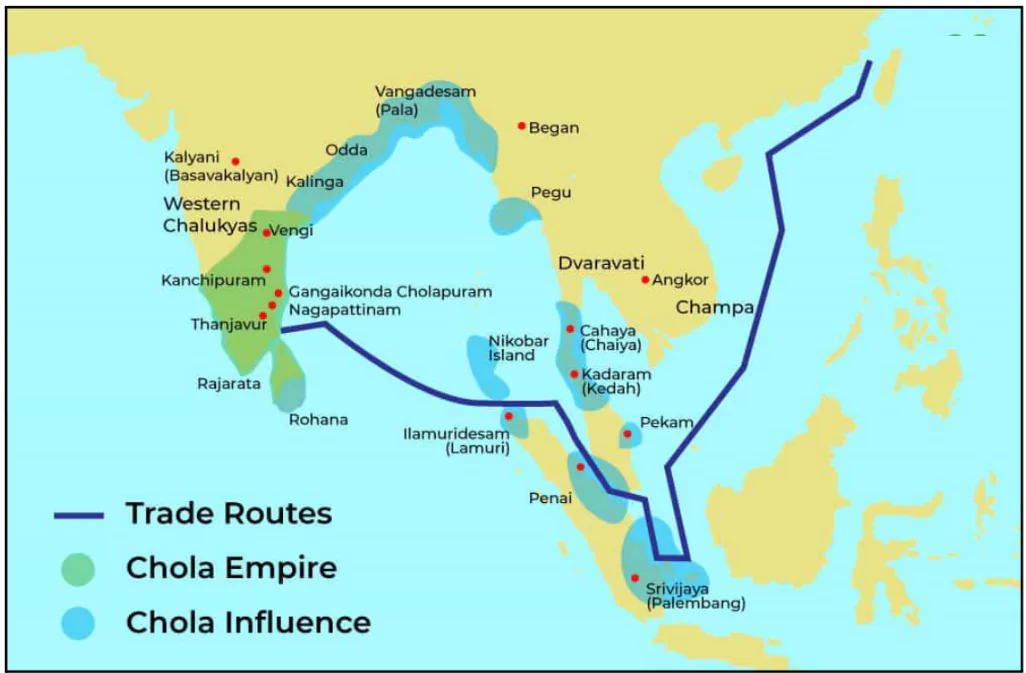Award-winning historian Anirudh Kanisetti, in his work Lords of Earth and Sea, highlights the decline of women’s influence in the Chola Empire and its widespread impacts.
- The research sheds light on how powerful women, who once played significant roles in South India’s royal courts, gradually vanished from historical records as the Chola dynasty transitioned from a sprawling empire to a regional power.
About the Chola Empire

- Origin and Early References: One of the Muvendhar (three mighty dynasties) of the Tamizh region.
- Mentioned in Sangam literature and Ashoka’s rock edicts.
- The Tamizh region, encompassing modern-day Tamil Nadu and parts of South India, is renowned for its rich cultural heritage, vibrant Dravidian traditions, and historical significance as the epicenter of ancient dynasties like the Cholas, Cheras, and Pandyas.
- Foundation and Revival: Revived in the 9th century under Vijayalaya Chola, who established Thanjavur as the capital after conquering the Kaveri delta from Muttaraiyar.
- Later Cholas traced their lineage to Karikala Chola of the Sangam age.
- Key Rulers:
- Raja Raja Chola I (985–1014 CE): Expanded the empire through naval expeditions to Sri Lanka, Maldives, and the West Coast.
- He constructed Brihadeeshwarar Temple at Thanjavur.
- Rajendra Chola I (1014–1044 CE): Extended territories to the Tungabhadra and Ganga rivers, founded Gangaikonda Cholapuram, and led naval expeditions to Southeast Asia.
- Cultural and Administrative Legacy: Known for advancements in architecture, maritime trade, and efficient governance.
- Promoted literature, temple-building, and local self-governance through village assemblies.
- Decline: Transitioned to a regional power by the 13th century, leading to the loss of central influence and royal women’s diminished roles.
Enroll now for UPSC Online Classes
Condition of Women During the Chola Period
Social Status
- Prominent Women in History: Women like Sembiyan Mahadevi, a pivotal figure in South Indian religious history, and Loka-Mahadevi, a temple builder and mother of emperors, had significant influence.
- By the 12th century, royal women’s presence in political and religious spheres dwindled. Women from rival families, such as Hoysala and Kadava princesses, were among the few to maintain some public role.
- Service Retinues: The institution of Service Retinues, which included palace women with social and ceremonial roles, declined by the 1230s.
Economic Contributions
- Temple Patronage: Women contributed economically through temple patronage, commissioning bronze sculptures and supporting religious activities.
- Temple Roles: As the Chola dynasty weakened, many women sought involvement in temple administration, gaining honorary positions and influence within these sacred spaces.
Political Involvement
- Early Influence: Chola queens and royal women wielded political influence, contributing to temple construction and diplomacy.
- Marginalization: With the rise of regional powers and internal turmoil, women lost their political clout. Many palace women, disconnected from their fraternal lines, faced precarious circumstances, especially when captured or neglected by the court.
Religious Roles
- Significant Figures: Women like Sembiyan Mahadevi shaped South India’s religious landscape through temple-building and endowments.
- Transition to Temples: During the 13th century, temples offered women a refuge and a means to maintain some level of influence through participation in religious affairs.
Check Out UPSC NCERT Textbooks From PW Store
Sources of Information
- Inscriptions from temples and royal records highlighting women’s roles and contributions.
- The share of women named in inscriptions peaked in the Rajaraja and Rajendra Chola periods, when the Cholas were at the height of their power
- Archaeological evidence from Chola temples, such as Brihadeeshwarar Temple in Thanjavur.
- Secondary historical analyses on South Indian dynasties.
![]() 22 Jan 2025
22 Jan 2025


